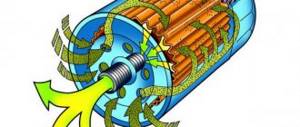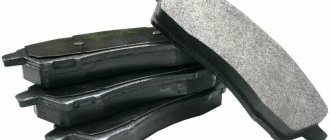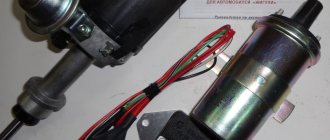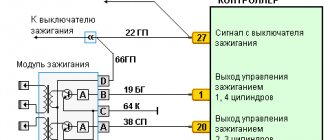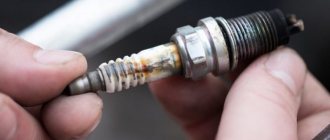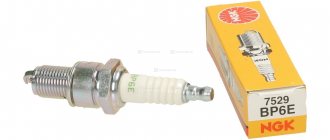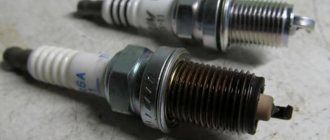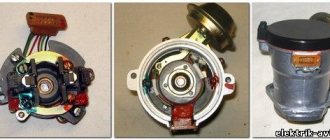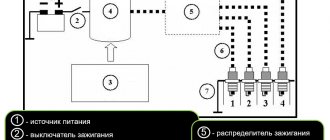1
Bosch FR7SI30 1.1 PLATINUM
Look
2
NGK BKR6EIX
Look
3
Denso PK20PR-P
Look
There are many car accessories on the modern market that are not directly related to the car manufacturer. This also applies to spark plugs, the purpose of which is to ignite the fuel-air mixture. The main reason for this state of affairs is the high cost of products from well-known brands.
The fee for the logo of a famous automobile concern is up to half of the total cost of the product. This article is an overview of the highest quality and not always expensive models of car spark plugs. For selection into the TOP 10, the following criteria were taken into account:
- reviews from car owners who have experience using spark plugs of one brand or another;
- expert opinion;
- cost/quality ratio;
- design features;
- manufacturing materials;
- set of operational characteristics;
- engine type: injector or carburetor (the gap in models for an injection engine is larger).
After familiarizing yourself with the advantages and disadvantages of the described models, you can easily choose the best spark plugs that are right for your car.
Bosch FR7SI30 1.1 PLATINUM
Bosch spark plug with platinum coating and improved performance characteristics. The material used to make the body of the working electrodes is nickel. However, they are equipped with platinum soldering tips with lower resistivity and greater resistance to high temperature loads and moisture.
Thanks to its design features, the product creates a stable and powerful spark in various engine operating modes, including under significant loads.
Technical features:
- the size of the interelectrode gap is 1.1 mm;
- thread pitch – 1.25 mm;
- external thread – 14.0 mm;
- number of side electrodes – 1;
- thread length – 26.5 mm.
Advantages of the model:
- reliable anti-corrosion protection;
- high level of efficiency compared to the classic nickel version;
- long working life;
- thin (0.6 mm) central electrode, providing better flammability;
- less noisy operation of the machine engine.
Among the disadvantages, buyers note the inflated cost and the high probability of purchasing a fake. There are also complaints from car owners who place a high load on the engine. In this case, this model is far from the best choice due to the small spark gap.
NGK LFR6A-11
The popularity of this spark plug lies in the fact that it combines a reliable design, the presence of a central electrode with a V-shaped tip, and an inexpensive price. In general, we can say that it is one of those “workhorses” that are installed on many European and Japanese cars. The V-shaped tip of the central electrode makes it possible to obtain a more stable and powerful spark, ensuring maximum combustion of the fuel mixture.
- The material of the central electrode is nickel.
- Its diameter is 2.5 mm.
- The side electrode material is nickel.
- The side electrode is standard.
- Thread diameter - 14 mm.
- The thread pitch is 1.25 mm.
- Thread length - 26.5 mm.
- The total length without thread is 50.5 mm.
- The gap between the electrodes is 1.1 mm.
- Heat number - 6.
Country of origin: Japan. Article number - 3672. Price for one piece is 215 rubles .
-= 9th place =-
NGK BKR6EIX
The difference between these candles, which sets them apart from similar products, is iridium coating. In this regard, this model significantly surpasses them in performance characteristics. The size of the interelectrode gap is 0.8 mm. This is the best option for a new engine. Thanks to the reduced gap size, the spark is stable.
The engine can be started even with an almost completely discharged battery. The working life is quite large and amounts to about 50 thousand km. And when using high-octane gasoline, this figure increases by another 15 thousand km. There is no particular saving in fuel consumption when using this model, but the service life is much longer.
The design is equipped with two electrodes: central and side. This option is optimal for drivers interested in stable engine operation.
The assembly is of very high quality, the level of corrosion resistance is high, which allows you to further extend the service life.
Advantages:
- availability. These candles are constantly on sale;
- long working life;
- iridium coating of electrodes;
- high quality workmanship.
There is only one minus: the high price. However, it is fully compensated by its long service life and excellent performance characteristics.
NGK BKR6EIX (6418) 522
Which iridium spark plugs are best? NGK is not inferior here either - its BKR6EIX iridium spark plugs are considered one of the best in terms of workmanship, but still do not meet Renault's requirements for the size of the interelectrode gap - only 0.8 millimeters. Such spark plugs are ideal for installation on a new engine without excessive oil consumption - stable sparking, coupled with a reduced gap, allows you to start the engine even when the battery is almost completely discharged.
With the right choice of fuel, the working life of iridium spark plugs can reach 50,000 kilometers. For frequent use of the car in different directions, it is better to purchase two sets of standard spark plugs for the same price, since disabling an expensive set of spark plugs due to the use of low-quality fuel will be an irrational decision.
Main advantages:
- Spark stability.
- Potentially large working resource.
Flaws:
- Non-compliance with the car manufacturer's requirements for the gap between the electrodes.
- The price is too high.
Denso PK20PR-P
A special feature of this line of spark plugs is the presence of sputtering on the platinum electrodes. The design of the product is simple, single-electrode, but in terms of spark formation quality, the product is in no way inferior to multi-electrode models. The manufacturing company was able to achieve the same durability as iridium products, but using platinum, which is cheaper.
Advantages:
- slightly higher cost than products that do not contain precious metals;
- long working life, significantly exceeding the replacement period established by the maintenance regulations;
- versatility. Modifications of this line are suitable for most cars, including those that have been discontinued;
- at high speeds - self-cleaning effect;
- good threaded connection;
- excellent quality seal ring;
- The product is always on sale.
There are also several disadvantages:
- It happens that the standard gap value does not correspond to the car manufacturer’s specifications, so you have to set it;
- the product does not tolerate prolonged idling very well and becomes covered with a layer of soot;
- poor compatibility with liquefied gas.
How car manufacturers decide which spark plugs to use
While some car owners are still confused about the best spark plugs to use in their cars, one fact remains: car manufacturers design their engines with specific characteristics, keeping in mind the model-specific efficiency of each configuration of their engine models.
This is the main reason why they recommend that you use the specific one for your machine. Please refer to your vehicle's owner's manual for the recommended model.
For example, older vehicle models - those from the early 1980s and earlier - perform better with copper, simply because their engines were designed with these types of parts in mind.
However, some late 1980s and newer models will see the benefits of using platinum for the same reason. Some late-model vehicles, including Lexus and Pontiac, require iridium spark plugs to improve efficiency, improve mileage, save gas, and extend service intervals.
Brisk Premium LOR15LGS
The model from Brisk is distinguished by excellent performance indicators and non-standard development. The spark plug has an unusual configuration of side electrodes. Due to the fact that they are made "looking down", the main electrode is surrounded by sparks along the entire length of the open part. Ignition of the fuel-air mixture occurs at the first stage of its entry into the combustion chamber. This contributes to quite noticeable fuel savings.
Advantages:
- high spark density, which is caused by improved electrodes;
- long operational period;
- economical fuel consumption.
Disadvantage: high price.
Rating of the best spark plugs
They are divided into several categories:
- Budget - up to 200 rubles;
- The average price range is from 200 to 500 rubles;
- Premium – from 500 rub.
Budget - up to 200 rubles.
BRISK L15Y
This type of spark plug has one central electrode made of a special nickel-based alloy. This allows the spark plugs to work perfectly on engines without catalysts. Has 1 side electrode. The electrodes are resistant to carbon deposits. The outside of the candle is galvanized with zinc for protection.
Characteristics:
- external thread – 14 mm;
- thread length – 19 mm;
- wrench – 16;
- distance between electrodes – 0.7 mm;
- heat number – 15 units.
Price – about 50 rubles. for 1 piece
Champion N9BYC4
This spark plug with 3 electrodes from French manufacturers, as the name suggests, is a real champion in the field of fuel economy and power increase (by 5.0-5.6%) compared to single-electrode spark plugs. The model is universal and is used on many brands of cars from Russian and foreign manufacturing companies. In addition, test results show that exhaust emissions have decreased by approximately 4%.
There is only one drawback: there are many fakes on the market. But this issue can be resolved if you shop only in trusted stores.
Multi-electrode spark plugs
Why does a spark plug need multiple side electrodes? After all, no matter how many there are - two, three or four - the high-voltage pulse generated in the depths of the coil will cause a single spark, which will “select” only one of the side electrodes. So, maybe this is just an elementary trick of marketers - they say, the more electrodes, the more expensive?
We decided to check it out. And the main test bench, as last time, was the VAZ eight-valve VAZ-2111 engine with fuel injection and a January 5.1 controller.
In fact, the advantage of multi-electrode spark plugs has long been known - it is a resource. After all, a spark occurs between the central and side electrodes in that spark gap, the electrical resistance of which is currently less than the others. And since the resistance changes each time, the spark “gnaws” the electrodes one by one. Take a look, for example, at a long exposure photograph of a Bosch spark plug discharge. During the shooting, about 50 discharges occurred, the sparks from which were evenly distributed between all three side electrodes. This, by the way, suggests that all three gaps here are approximately the same. But even if this is not the case and the spark hits only one electrode, then over time it will “gnaw” it and spread to the adjacent one, thereby extending the service life of the spark plug.
True, multi-electrode spark plugs are more expensive than regular spark plugs. And therefore, automakers use them only in those engines where the price can not be controlled. For example, the engine of the editorial BMW 320i sedan, which we operated in 1998-2002, had four-electrode NGK spark plugs, which served the required 100,000 km without any problems.
But, unfortunately, we are not able to check the service life of the candles during a short test. But we can find out how much the power, efficiency and exhaust toxicity of a VAZ engine changes when working with different spark plugs. And the fact that replacing spark plugs affects engine performance is a fact - during the previous test of single-electrode spark plugs, the difference in power reached almost 6%!
This time there are only seven sets of candles. These are Czech candles Brisk Extra
and
Brisk Premium
, German
Bosch
and
Finwhale
, French
Beru
, Japanese
NGK
and
Champion
made in the European Union. We did not find any domestic multi-electrode spark plugs.
First of all, all the spark plugs went into the pressure chamber to check for uninterrupted sparking under pressure. Due to the fact that the pressure chamber is filled not with a fuel-air mixture (explosive!), but with air, and the voltage supplied to the spark plug is reduced from the standard 22 to 17 kilovolts (imitation of extreme conditions), these tests are only an additional test. However, having carried it out, we will be able not only to compare different spark plugs under the same conditions, but also about the electrodes. And it exists!
For example, if a Bosch WR7DC
gives a missed spark at an air pressure in the pressure chamber of 8.1 atm, then its three-electrode “brother”
Bosch W7DTC
lasted up to 10.0 atm.
The picture is similar with other kits - the NGK BUR6E
T spark plug with three “mass” electrodes sparks stably at air pressure up to 10.4 atm, and the single-electrode
NGK BPR6E
gives out already at 8.9 atm.
What does this mean? That additional “mass” electrodes increase the reliability of sparking. This was confirmed when measuring the pressure of the complete cessation of sparking. The best result of three-electrode spark plugs (Brisk Extra
, 12.5 atm) is slightly higher than the result of the leader among single-electrode sets (
Brisk LR15YC
, 12.0 atm).
For other spark plugs, the difference is more noticeable - for example, three-electrode spark plugs from Bosch
lose their functionality at an air pressure in the pressure chamber of 11 atm, and single-electrode plugs - already at 8.4 atm.
The reliability of sparking depends not only on the number, but also on the location of the side electrodes. Take a look at the photo of the Brisk Premium LOR15LGS
. Its “mass” electrodes are located so far from the central one that even 5.5 atm of air pressure is enough to completely disappear the spark. According to tests in a pressure chamber, these spark plugs are inferior even to standard single-electrode spark plugs EZ A17DVRM! The resistance of the gap is too high and it cannot be “pierced” with a reduced voltage of 17 kV. But, of course, the conditions that we simulate in a pressure chamber are an extreme. This happens, for example, in a car with a weak battery in rainy weather, when the headlights, windshield wipers, and heated glass are on, and moisture that gets on the high-voltage wires increases leakage currents...
So the main test is the motor stand. We wrap each set of spark plugs in turn in an eight-valve VAZ-2111 engine with distributed injection (controller January 5.1 2111-1411020-61, lambda probe, without converter), connected to a load device. No load - the engine is idling. We increase the load - we measure “partial” characteristics. Full load - nominal mode. We record engine torque, rotation speed, fuel and air consumption, and exhaust gas toxicity. And in order to exclude even minimal changes in pressure, humidity and temperature in the laboratory where the load stand is installed, we bring all the results obtained to standard conditions according to the GOST 14846-81 “Automotive engines. Bench testing methods." The basis for comparison is the characteristics of the motor when working with standard single-electrode spark plugs A17DVRM from Engels.
First - gas to the floor! At full throttle, we measured the engine torque (and power) with each set of spark plugs. Here, as among single-electrode spark plugs, the Finwhale kit distinguishes itself. With these spark plugs, the engine developed 6.3% more power than with standard single-electrode spark plugs EZ A17DVRM - and 0.4% more than with single-electrode spark plugs Finwhale F510 (5.9%). Also in the top three are Champion candles (+5.6% power) and Brisk Premium (+5.1%). But the three-electrode Bosch performed modestly - the increase in power was only 2.6%.
Then, after slowing down, we measured the engine's efficiency in the urban cycle. It is interesting that none of the kits managed to surpass the result of single-electrode NGK spark plugs (a 5.1% reduction in fuel consumption relative to standard EZ spark plugs). But in general, multi-electrode spark plugs performed more consistently - a reduction in fuel consumption of more than 3% is provided by four out of seven sets: Beru (4.2%), Champion (4.1%), NGK (3.9%) and Bosch (3. 2%). But Czech Brisk Extra spark plugs do not reduce fuel consumption compared to standard EZ ones, but increase them by 1.6%.
Brisk Extra spark plugs also failed when measuring exhaust gas toxicity, which we carried out at idle, in urban cycle modes and in external speed characteristics. These spark plugs, like the single-electrode Bosch WR7DCX, forced the January 5.1 controller to work in a mode of constant correction of fuel injection timing, over-riching the mixture. As a result, it is “unsatisfactory” in terms of ecology. What is the reason - is it really also a missed flash?
And Beru four-electrode spark plugs are leaders in reducing toxicity. Behind them are Brisk Premium and NGK.
As usual, we converted the results of all tests into points and summed them up taking into account weight coefficients. In the group of leaders, the final scores were very “tight” - as in the tests of famous tires. In principle, we safely recommend all candles, except for the outsiders Brisk Extra LR15TC. By the way, if compared with the test results of single-electrode spark plugs, the best of them (this is NGK) could only take fourth place in the overall standings. This means that “additional” electrodes affect not only the service life, but also such engine characteristics as power, efficiency and toxicity.
By the way, multi-electrode spark plugs achieved the most outstanding results in reducing toxicity: if Eyquem, the leader among single-electrode sets, showed a 40% reduction in the content of CO and CH in the exhaust, then Beru Ultra-X - almost 60%! This suggests that the “multi-electrode” and the associated reliability of sparking manifest themselves especially clearly at partial load modes (at which we mainly checked the toxicity indicators). But you shouldn’t expect any miracles from multi-electrode spark plugs.
However, the processes of ignition of a combustible mixture from a spark still keep many secrets even for serious researchers - and, of course, attract the attention of inventors and brilliant engineers. What if you cut the side electrode in half? Or weld a cone to a candle and call the resulting miracle a “plasma generator”?
Similar candles are available on the shelves in abundance. We came across quite a few original designs - spark plugs “with a pre-chamber”, with a sawn or drilled side electrode. There was even a spark plug with a central octopus electrode - it sparkled like a gas stove burner!
Denso K20TXR
This model allows you to save money without overpaying for a car logo. In appearance and structure, the model has no differences with modifications that are produced to order from automobile concerns. There is not the slightest difference with the original, except for the relatively low price.
The coating of the candles is nickel, so this brand belongs to the inexpensive category. Persistent sparking is ensured by several side electrodes.
Advantages:
- complete absence of manufacturing defects, the quality of workmanship is almost impeccable;
- the cost is significantly lower than that of platinum analogues, with a complete absence of qualitative differences;
- excellent protection against spark erosion;
- the nut has fairly wide slots;
- high level of corrosion resistance due to nickel coating;
- Quite a high working life for a budget model without the use of precious metals.
The model is not without some disadvantages:
- inconvenience when adjusting the gap due to the high strength of the side electrodes;
- not very good performance results when using liquefied gas.
Beru Ultra-X 79
This candle is an example of a combination of excellent consumer characteristics with economical cost. Its specificity is that the manufacturer regulates the incompatibility of this product with LPG. Buyers in reviews, on the contrary, point to the excellent performance of candles with natural gas.
The model is equipped with 4 electrodes located at different distances from the core. Two of them have a 0.8 mm gap, the remaining 2 have 1.2 mm. This makes it possible to obtain a stable spark under various operating conditions, in particular if the insulator is heavily smoked. A simple and reliable design simulates a surface discharge.
Advantages:
- of the multielectrode designs, this is the most economical;
- environmental cleanliness. The exhaust contains a minimum of toxic substances;
- good spark quality if the electrodes are very dirty;
- stable operation with liquefied gas;
- The car engine is not so noisy.
Minuses:
- an open throttle valve does not provide a significant increase in power. The indicator does not exceed 3.0-3.5%;
- impossibility of setting gaps in accordance with machine specifications.
Which spark plugs are suitable for popular car brands?
To select spark plugs for your car, you must take into account their size and heat rating. Otherwise, it simply will not fit in the intended place. The easiest way is to purchase the same model as before.
When choosing spark plugs for your car, approach it responsibly, since the proper operation of the car depends on them. Consider the car brand, main characteristics and manufacturer rating. In addition, when choosing, focus on financial capabilities.
The choice is always yours. We hope that this article will expand your knowledge about spark plugs for cars and help you make the right choice.
Happy shopping!
Bosch WR7DP
A candle whose central electrode has an innovative structure: a thin core is recessed flush into a ceramic insulator. At the same time, the spark resembles a plasma discharge and works stably if the on-board voltage is reduced. It was possible to increase the service life between replacements to 60 thousand km through the use of a platinum coating, but this only works with proper fuel quality.
The cost is quite high, but this option is cheaper compared to iridium analogues.
Advantages:
- Platinum coating lasts longer due to the original structure of the central electrode;
- stable start, even if the on-board network voltage is reduced;
- a spark with a shape similar to a plasma-torch system;
- central contact with high quality coating;
- the possibility of a 5 percent increase in power without increasing gasoline consumption if the throttle valve is fully open;
- availability of modifications for most cars, including those from domestic manufacturers;
- environmentally friendly exhaust.
Minuses:
- greater fuel consumption when compared with conventional spark plug models;
- relatively high price. Moreover, most buyers believe that this is a fair price for excellent performance.
Types of Spark Plugs
Most spark plugs that are installed in car engines are divided into 4 large groups:
- Standard;
- Multi-electrode type;
- Plasma-prechamber;
- Platinum and iridium.
Video: Which spark plugs are better
Standard
This is the most common and popular group. Any motorist has seen such candles. They are distinguished by a ceramic body and a glass made of metal. This type of candle has a pair of electrodes - one is central, and the second goes around it from the side and from above. The diameter and width of the electrodes reaches 2.5 mm.
This is what standard spark plugs look like
Such candles are valued for their ease of production, which makes it possible to set affordable prices. However, they do not reveal the entire expression of the engine, although some are capable of improving certain indicators.
Multi-electrode type
Multi-electrode spark plug
In this case, there are several side electrodes, which is a design feature. Such a candle has a central electrode, which is surrounded on all sides by side electrodes, and they do not overlap the central one, as in the standard version, but simply adjoin it. Visually, such a candle is easy to distinguish from a standard one.
This type has a different spark generation principle. As one of the side electrodes becomes clogged (carbon deposits appear), a spark begins to flow from the adjacent one. This arrangement ensures not only stable operation of the spark plug, but also a longer service life.
Another advantage of a multi-electrode spark plug is that on a standard spark plug, the side electrode hangs over the central one, overlapping it. This somewhat worsens the combustion of fuel. A multi-electrode spark plug has an open central electrode, so nothing prevents the spark. This guarantees optimization of fuel consumption, environmental performance and increases the elasticity of engine operation.
Plasma-prechamber
Prechamber spark plugs
A new type of spark plugs, characterized by the ability to self-clean and have an increased service life. Their design is completely different from the standard one, since they do not have a side electrode. Its function lies on the spark plug body itself - the spark goes in a circle in it.
Platinum and iridium
Such candles are distinguished not so much by their design as by the material used for their manufacture. They owe their appearance to tests carried out by engineers. Experts have noticed that thinning the spark plug electrodes improves its performance - engine power increases, since a powerful spark occurs at the sharp end of the electrode.
However, it was necessary to solve the problem of rapid wear, because simple steel (alloyed with manganese or nickel) could not withstand such loads. In search of a more suitable metal, 2 options were chosen:
- Iridium;
- Platinum.
Another strong point of this candle is its self-cleaning. The reason is that the spark comes out of the sidewall, and not the end, which allows you to literally remove carbon deposits. However, the price of such candles is much higher.
Beru Z193
A fairly popular model of spark plugs, characterized by a low price. Practice shows that they “live” without problems for the entire period between two technical services. As they say, the model “doesn’t have enough stars in the sky,” but at the same time it is distinguished by stable performance indicators, including at high engine speeds.
If you are a fan of high speeds, these spark plugs are unlikely to be suitable, but for the average driving style this option is optimal. The design has 1 electrode, therefore it is inferior in terms of working life to multi-electrode analogues. The cost of the products is low, so the likelihood of purchasing counterfeit goods is almost zero. It is simply not profitable to counterfeit these candles.
The spark gap is small. Thanks to this, it is possible to start the engine, even if the battery is significantly weak. However, the loss of spark power is significant. Misfires are possible due to a combination of low fuel quality and heavy loads on the engine.
The central electrode is made slightly recessed. This complicates ventilation in the spark gap, which contributes to the formation of carbon deposits.
Pros:
- relatively low price;
- the ability to start the engine even when the battery is dead;
- absence of fakes on the market;
- the best option for car enthusiasts who avoid excessive loads on the engine.
Minuses:
- low-power spark;
- formation of carbon deposits due to the recessed electrode.
Which spark plugs are better
When choosing among analogues of a given spare part, buyers want to choose the best manufacturers in terms of quality or price. In November 2020, the TOP 8 best spark plugs on PartReview looked like this:
- Torch - 84% positive votes. Average rating: 4.1
- BRISK - 79% positive votes. Average rating: 3.9
- Denso - 76% positive votes. Average rating: 3.8
- Bosch - 75% positive votes. Average rating: 3.8
- Finwhale - 75% positive votes. Average rating: 3.7
- BERU - 74% positive votes. Average rating: 3.8
- NGK - 71% positive votes. Average rating: 3.7
- Champion - 61% positive votes. Average rating: 3.3
NGK BPR6ES
This model from the Japanese company NGK is a good option for replacing standard spark plugs. The standard line has many modifications that allow you to select the desired option with the greatest accuracy. The main feature of the model is a spark of increased power, which allows you to ignite the combustible mixture equally effectively throughout the entire operational period. The replacement interval recommended by experts is 30.0 thousand km. The material used to make the electrodes is nickel, so the model is distinguished by its low cost.
Advantages:
- long working life;
- high level of reliability;
- almost flawless engine operation;
- low cost.
There is only one drawback: a huge number of Chinese-made counterfeits thrown onto the market. They are significantly inferior in operational parameters to the Japanese original.
How to choose spark plugs
Trouble-free starting of a car engine and its stable operation are determined not only by the serviceability and flawless functioning of its systems, but also by the correct choice of spark plugs. A competent approach to purchasing these accessories will help prevent such problems:
- constant expenses for replacing spark plugs due to frequent breakdown of newly purchased ones;
- increased fuel consumption;
- breakdown of the socket for installing a candle.
Classification
The first sign by which different types of candles are distinguished is the number of electrodes:
- two-electrode designs are equipped with 2 electrodes: central and side;
- multi-electrode spark plugs have several (three or more) side electrodes (for example, three-electrode options).
The advantage of the multi-electrode design is that the engine runs stably due to the increased likelihood of spark formation. If one of the elements does not work, the other “helps out”.
Multi-electrode or multi-contact designs are also distinguished by a longer operating life.
Manufacturing materials
The following types of materials are used to make burning candles:
- a combination of alloy steel with metals such as nickel, chromium and manganese;
- sputtering a layer of platinum;
- coating with iridium film is the most expensive option.
The first type of product is considered classic. Numerous tests have shown a good working life of nickel electrodes. The copper core successfully removes heat, which avoids thermal overload. The standard option is the most budget-friendly due to the use of relatively cheap materials.
Platinum spark plugs have recently appeared on the market, so they can rightfully be considered an innovation in the automotive industry. New models are distinguished by a longer period of use due to the use of noble metal. In addition, the use of platinum contributes to the stable power generated by the engine under different operating conditions. The thickness of the electrode is less than that of classic models.
The goal of developing iridium spark plugs is to reduce ignition voltage and optimize flame distribution. Iridium is a hard, chemically resistant metal that is not subject to corrosion. Thanks to this, it was possible to create a thin but unusually durable electrode. These are products from the “set it and forget it” category. The working life of these products, as tests show, is very long, but the cost, when compared with classics, is several times higher.
additional characteristics
Before you buy spark plugs, you need to carefully study the table of technical characteristics, since these parameters play an important role when choosing:
- heat number is an indicator of the temperature regime of the product. With a high heat value, the spark plug itself heats up less. If it is low, then the product becomes very hot, which can lead to burnout of the gaskets and pistons. The specific choice depends on the parameter specified in the car’s operating manual. Products with a low heat rating cannot be used;
- spark gap. This is the name of the interval between the central and side electrodes. Sometimes you have to change this parameter to suit your own car, but experts do not advise doing this unless absolutely necessary. The efficiency of the spark plug may be reduced;
- thread parameters: diameter and length.
Labor resources are also important. If the product is selected correctly, it will work for the period between vehicle services without any problems. However, this rule works if there are no problems with the health of the engine or fuel system.
What spark plugs are popular?
At the same time, users are often interested in which good spark plugs they buy more often than others. In November 2020, the TOP 8 popular spark plugs on PartReview looked like this:
- Denso - 709 votes
- NGK - 606 votes
- BRISK – 465 votes
- Bosch - 402 votes
- Finwhale - 248 votes
- Torch - 198 votes
- BERU – 144 votes
- EYQUEM – 90 votes
- — 87 votes
- Motorcraft - 80 votes
